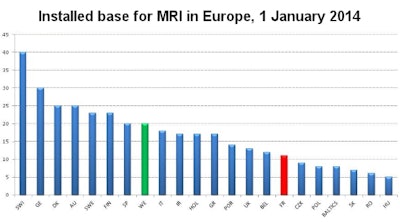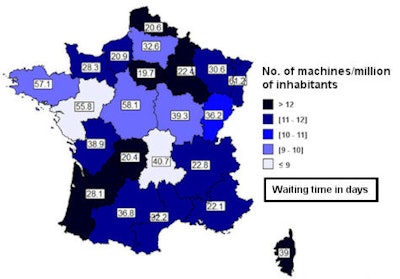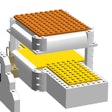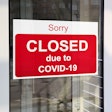
Average MRI waiting times in France have improved slightly over the past year, returning to the 2012-2013 levels of 30.3 days, according to a report from the Imaging Health Future (Imagerie Santé Avenir, ISA), which represents the imaging industry. But some radiologists fear the country lags well behind many other European nations and patient care is suffering.
This improvement on waiting times in 2013-2014, which were the longest in 11 years at 37.7 days, is due to 77 new MRI units being installed across several regions last year, bringing total installations in France to 761, compared with 684 in 2014. However, half of the country's population lives in regions in which it takes 25 days or more to obtain an MR scan, and this may significantly reduce a patient's prospects, according to the report.
The current average waiting time is still 10 days longer than the target proposed by the government's National Cancer Plan for 2014-2019, which aimed to cut the national average to 20 days. This goal is less ambitious than the previous cancer plan, which aimed to cut MRI waiting time to 15 days and to 10 days in regions with high cancer-related mortality.
"As usual, this report points out a disaster. The French government is always reluctant to face the truth. The so-called cancer plan highlighted the lack of MR equipment needed, but nothing has been done to answer the need," said Dr. Philippe Soyer, chairman of the radiology department at Hôpital Lariboisière Paris and general secretary of the Syndicate of Hospital Radiologists (Syndicat de Radiologues Hospitaliers, SRH). "Instead of increasing MRI units, which would be the best answer to the long MR delays, the government prefers to provide free care to everybody. But how can you offer free care if there is no way to provide it?"
Demand for cardiac MR exams is rising fast, and brain MR exams also are increasingly indicated for stroke, but the increase in the number of MR scans required was not anticipated, he added.
"As a result, the mean delay is rising. The delay in some areas may reach up to two months or even longer for a patient with a suspicion of liver cancer. But this is not only true for MR. It is also true for surgery or external radiation therapy," Soyer said. "We cannot take care of outpatients, and we must limit our services to inpatients to shorten waiting times."
He noted that Hôpital Lariboisière is a tertiary care, 600-bed center that sees 100,000 emergency patients per year, but the department's two MR units are not sufficient.
Regional inequalities
The long waiting times are predominantly blamed on a lack of MR machines, with France remaining far behind other European states with 11.9 MRI devices per million inhabitants, compared with an average of 20 across the rest of Europe according to 2014 statistics (see graph).
 France has relatively few MR scanners compared with other countries (WE = Western Europe). All figures courtesy of Cemka-Eval.
France has relatively few MR scanners compared with other countries (WE = Western Europe). All figures courtesy of Cemka-Eval.The latest ISA report describes how just five regions benefitted from 38 of the 77 new MRI units installed in 2014: Basse Normandie, Nord Pas-de-Calais, Provence Alpes Côte d'Azur (PACA), Midi-Pyrenées, and Ile de France. Conversely, four regions obtained no new equipment: Auvergne, Centre, Franche-Comté, and Languedoc Roussillon. Pays-de-la-Loire has the lowest ratio in France with 8.1 MRI machines per million inhabitants, and a waiting time of 55.8 days, according to the report.
Waiting times in Brittany for an MRI exam have more than doubled in two years to 57.1 days in 2015, compared with 24.2 days in 2013. In Alsace, a region with high cancer incidence, waiting times now average 61 days. In Poitou-Charente, waiting times have climbed from 28.6 days in 2013 to 38.9 days in 2015. Only Ile de France has experienced a drop in waiting times to fewer than 20 days for an MRI exam.
Cemka-Eval, which conducted the research for ISA, also studied the effect of the recently introduced osteoarticular-dedicated MRI units. Nearly half of the units installed in 2014 were aimed at osteoarticular MRI, in line with the policy of France's health authorities.
A total of 40 of the 622 sites (6.4%) had such a dedicated machine, and these were located across 22 regions, including Ile de France, Rhône-Alpes, and Lorraine. Only 33 of these sites had specialist systems installed at the end of 2013 and could be used in a "before" and "after" comparison. Initial results suggested that waiting times for an oncologic exam clearly diminished where there was a specialist osteoarticular-dedicated MRI system installed, from an average of 31.5 days in 2013 to 20 days in 2015.
The average waiting time in 2015 for MRI at the 40 sites with such systems is 23 days, compared with 31 days at sites with only "general" MRI systems. However, the report's authors stressed it was too early to be confident here, and they stated that the installation of this type of machine prioritized osteoarticular exams, often scheduled and nonemergency, potentially to the detriment of other growing needs in emergency public health.
 Huge differences in terms of access to MRI persist in France.
Huge differences in terms of access to MRI persist in France.Besides varying regional health policies, another factor compounding the regional differences may be the lack of radiologists available to run services, according to Soyer.
"Some facilities in small towns have MR equipment because local politicians used their influence to get them, but there are no radiologists to run them," he told AuntMinnieEurope.com. "The solution is to have more radiologists onsite. But this simple and self-evident answer is not considered by the government."
While the general shortfall in MRI systems and a rise in indications for MR examinations is not in question, doubts persist over the methodology of the study, which has involved the same fictitious scenario each year since the research started in 2003: a daughter telephoning imaging centers to make a lumbar MRI appointment for her father, who has a history of colon cancer and for whom there is now a suspicion of metastases.
"This scenario is preposterous. If an MRI exam is needed, the physician picks up the phone and discusses the matter with a radiologist," said Dr. Robert Lavayssière, staff radiologist and CEO of Centre d'Imagerie Paris-Nord, Sarcelles, France, and a member of the editorial advisory board of AuntMinnieEurope.com.
He said this situation has persisted for years, and the report said nothing new about the inequality in MRI access between France and other countries, as well as between regions. The French Society of Radiology (Société Française de Radiologie, SFR) and the Fédération Nationale des Médecins Radiologues (FNMR, the private practicing radiologists' union) remained committed to lobbying for higher numbers of MR units across the country, he noted.
Access influences patient care
The FNMR has also added its weight to the argument. In a statement released earlier this month, the federation said its members were worried about the long average delays and the deepening disparity between regional waiting times.
"The consequences of this shortage in equipment are significant: The risk of lowered chances for patients -- let's not forget that this study is about requesting MRI when there is suspicion of a cancer returning -- unequal access to MRI, and, therefore, unequal patient chances per region; and insufficient substitution of conventional radiology by the nonirradiating technique of MRI," the FNMR pointed out.
The FNMR supports the introduction of osteoarticular-dedicated systems to relieve multipurpose MRI. It noted initial results reveal a reduction in waiting times for general MRI when an osteoarticular-dedicated system is used.
"The FNMR calls once again on the government to continue its efforts to reduce the average waiting time for MRI, given that this figure has not dropped below 29 days in 12 years. This concerns the health of French citizens, every patient should benefit from the best diagnostics and treatment, and this in the shortest delay," the FNMR concluded.
The SFR also posted its formal response to the report on its website confirming that this 12th study, indicator of quality and equality of access to care, revealed that waiting times remained at an elevated level. In January, SFR stated the lack of MRI led to unsuitable, costly, useless, and irradiating "substitute" exams, and urged radiologists to consult its good practice guide: gbu.radiologie.fr.
Long waiting times for MRI in an oncological emergency pose a real problem in terms of ethics, responsibility, and lowered patient chances, according to ISA. The report concluded that MRI needs are increasing 6% to 12% each year, necessitating a sustained increase of 100 new MRI installations per year over the next five years until 2020. This would shorten average waiting times to fewer than 30 days and meet the needs of a growing -- and an increasingly aging -- population.



















